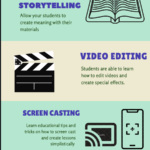This video provides a brief description and educational understanding of descriptive language in grades 4-6. This video is a great addition to a lesson plan, introduction, or review to amplify students understanding of the material.
- What kind of interaction would the video require from your students? Does it force them to respond in some way (inherent)?
The video includes the interaction, designed interactivity, as it provides pauses for students to answer questions and test their understanding, however, they are still able to listen and observe without answering (Bates, 2019). Throughout the educational video, it explains a phrase/word that connects to descriptive language and a short activity to check for understanding. This video would be great to test for comprehension or initial understanding because of the ability to observe or answer questions.
2. In what way are they likely to respond to the video on their own, e.g. make notes, do an activity, think about the topic (learner-generated)?
This video is fairly quick and does not allow for ample time of thinking and answering critically, therefore for students to answer and apply their knowledge they would need a prior understanding of the material. This would be a learner/self interactive activity as the students are answering open-ended prompts and are developing their metacognitive skills (James, 2021). In my Interactive Learning Resource group, this video would be useful at the end of the lesson to show the students’ comprehension of the material.
3. What activity could you suggest that they do, after they have watched the video (designed)? What type of knowledge or skill would that activity help develop? What medium or technology would students use to do the activity?
To relate to my group’s Interactive Learning Resource, I would put this video on right before their “create a monster” short story. They are writing a personal short story of their descriptive monster from previous activity. Therefore, it is near the end of the lesson and students would have a good understanding of the material. This gives everyone a review of each concept to ensure they are prepared for their writing assessment. This activity would help the students recall each concept used within the lesson on descriptive language and help strengthen their writing. Students would use a mentor text and laptops to write and review their previous “create a monster” activity sheets to complete this activity.
4. How much work for you would that activity cause? Would the work be both manageable and worthwhile? Could the activity be scaled for larger numbers of students?
This activity would involve a formative progression, and then work towards a final summative copy. Thus, students will be able to collaborate and peer review each other’s work to strengthen their descriptive language. Our group also styled our activity as a writers workshop, so as the students are writing, the teacher is having one-on-one meetings with everyone to see each student’s development and progression. The students then use their rough draft to produce a summative copy to submit for assessment.
This would not require a lot of work as the teacher gives feedback while the students work and they are able to review each student’s progression. Students work together to encourage collaboration and practice editing. This is both manageable and worthwhile as it helps not only the student’s writing but also other students as well. This activity is sustainable for a large classroom and amplifies students’ and teachers’ time through peer editing and feedback during their personal progression.
References
Bates, A. W. (T. (2019, October 10). 9.6 Interaction. Teaching in a Digital Age Second Edition. https://pressbooks.bccampus.ca/teachinginadigitalagev2/chapter/pedagogical-roles-for-text-audio-and-video/.
James, H. (2021). Assessing Interaction. EdTech EDCI 335. https://edtechuvic.ca/edci335/assessing-interaction/



